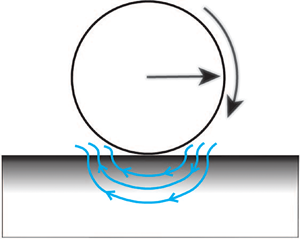Published online by Cambridge University Press: 17 March 2022

A lubrication analysis is presented for the resistances between permeable spherical particles in near contact,  $h_0/a\ll 1$, where
$h_0/a\ll 1$, where  $h_0$ is the minimum separation between the particles, and
$h_0$ is the minimum separation between the particles, and  $a=a_1 a_2/(a_1+a_2)$ is the reduced radius. Darcy's law is used to describe the flow inside the permeable particles and no-slip boundary conditions are applied at the particle surfaces. The weak permeability regime
$a=a_1 a_2/(a_1+a_2)$ is the reduced radius. Darcy's law is used to describe the flow inside the permeable particles and no-slip boundary conditions are applied at the particle surfaces. The weak permeability regime  $K=k/a^{2} \ll 1$ is considered, where
$K=k/a^{2} \ll 1$ is considered, where  $k=\frac {1}{2}(k_1+k_2)$ is the mean permeability. Particle permeability enters the lubrication resistances through two functions of
$k=\frac {1}{2}(k_1+k_2)$ is the mean permeability. Particle permeability enters the lubrication resistances through two functions of  $q=K^{-2/5}h_0/a$, one describing axisymmetric motions, the other transverse. These functions are obtained by solving an integral equation for the pressure in the near-contact region. The set of resistance functions thus obtained provide the complete set of near-contact resistance functions for permeable spheres and match asymptotically to the standard hard-sphere resistances that describe pairwise hydrodynamic interactions away from the near-contact region. The results show that permeability removes the contact singularity for non-shearing particle motions, allowing rolling without slip and finite separation velocities between touching particles. Axisymmetric and transverse mobility functions are presented that describe relative particle motion under the action of prescribed forces and in linear flows. At contact, the axisymmetric mobility under the action of oppositely directed forces is
$q=K^{-2/5}h_0/a$, one describing axisymmetric motions, the other transverse. These functions are obtained by solving an integral equation for the pressure in the near-contact region. The set of resistance functions thus obtained provide the complete set of near-contact resistance functions for permeable spheres and match asymptotically to the standard hard-sphere resistances that describe pairwise hydrodynamic interactions away from the near-contact region. The results show that permeability removes the contact singularity for non-shearing particle motions, allowing rolling without slip and finite separation velocities between touching particles. Axisymmetric and transverse mobility functions are presented that describe relative particle motion under the action of prescribed forces and in linear flows. At contact, the axisymmetric mobility under the action of oppositely directed forces is  $U/U_0=d_0K^{2/5}$, where
$U/U_0=d_0K^{2/5}$, where  $U$ is the relative velocity,
$U$ is the relative velocity,  $U_0$ is the velocity in the absence of hydrodynamic interactions and
$U_0$ is the velocity in the absence of hydrodynamic interactions and  $d_0=1.332$. Under the action of a constant tangential force, a particle in contact with a permeable half-space rolls without slipping with velocity
$d_0=1.332$. Under the action of a constant tangential force, a particle in contact with a permeable half-space rolls without slipping with velocity  $U/U_0=d_1(d_2+\log K^{-1})^{-1}$, where
$U/U_0=d_1(d_2+\log K^{-1})^{-1}$, where  $d_1=3.125$ and
$d_1=3.125$ and  $d_2=6.666$; in shear flow, the same expression holds with
$d_2=6.666$; in shear flow, the same expression holds with  $d_1=7.280$.
$d_1=7.280$.